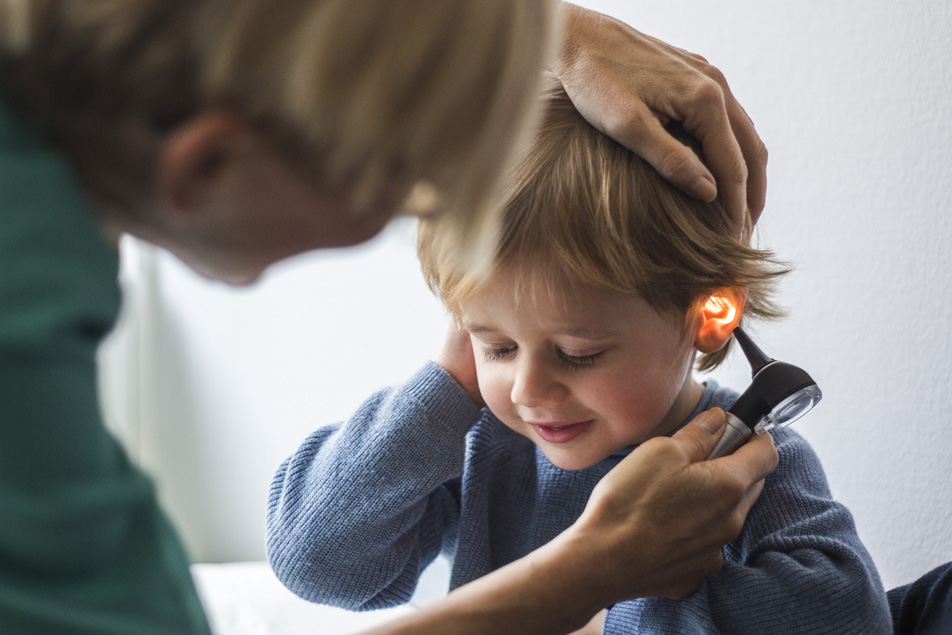
Many children experience ear pain, but it can be challenging to know whether your little one suffers from an earache or an ear infection. Fortunately, Allison Meyer, MD, PPG – Pediatrics at Parkview Huntington Hospital, helps answer our questions regarding these ear ailments and how to differentiate between the two.
What are the common culprits of ear pain?
While there are many reasons for a child to experience ear discomfort, some of the most common causes of ear pain can include:
- Otitis media: An infection of the middle part of the ear and often occurs as a result of a cold, sore throat or respiratory infection.
- Otitis Externa: An infection of the outer ear canal caused by moisture remaining in the ear after swimming or even showering, thus creating a perfect environment for bacteria or fungi to grow.
- Eustachian tube dysfunction: This is increased pressure in the middle or inner ear and usually occurs due to nasal congestion, allergies or a cold.
- Impacted ear wax: A buildup of too much wax within the ear canal.
What’s the difference between an earache and an ear infection?
An earache is a pain in the ears, affecting one or both ears, and isn’t always due to bacterial infections. Ear infections, on the other hand, are caused by a bacterial or viral infection. Bacterial infections usually require treatment such as antibiotics.
Who is most susceptible to earaches and/or ear infections?
While adults are certainly susceptible to earaches and ear infections, this type of ear discomfort is prevalent in children whose eustachian tubes (a canal that connects the middle ear to the nasopharynx) are flatter, and those children who are not fully vaccinated. Typically, there is an increase in incidences between ages 6-12 months, and then it peaks again at 5-6 years of age. Fortunately, as children get older, it is less likely that they will experience recurrent ear infections.
What are the signs and symptoms of an ear condition?
Unfortunately, the symptoms of an earache do not always differ from those of an ear infection, which means it can be difficult to identify the cause of your child’s ear pain without an exam. Some behaviors and symptoms to watch for can include:
- Fever (temperature higher than 100.4°F)
- Tugging or pulling at the ear
- Fussiness or crying
- Irritability
- Restless sleep
- Decrease in appetite
- Fluid draining from the ear
Also, ear pain can range in severity from a mild, dull ache to sharp, burning or throbbing sensations in one or both ears.
How are earaches and ear infections diagnosed and treated?
Earaches and ear infections are often diagnosed based on the symptoms a patient exhibits and by way of a physical examination. Your child’s provider will likely use a lighted instrument called an otoscope to look in the ears, throat and nasal passage. A tympanogram may also be utilized during an exam to allow the provider a chance to see the middle part of the ear by changing pressures in the ear canal. It’s not painful and sits on the outside of the ear like an otoscope.
For treating either ear affliction, your provider may instruct you to employ the following:
- Antibiotics for bacterial infections
- Medicines for pain relief and fever
- Observation or watchful waiting (if the infection isn’t bacterial)
- A combination of the above
Can earaches and ear infections be prevented?
Typically, the recommended immunizations given during well-child visits, particularly the pneumococcal vaccine, can help reduce the risk of recurrent ear infections. Breastfeeding, avoiding secondhand tobacco smoke and surgical placement of tubes in a child’s ears can also help mitigate recurrent infections.
What can parents/caregivers do to help their children through the pain?
Parents and caregivers can utilize acetaminophen and ibuprofen (if six months of age or older) to help ease any pain and discomfort. Additionally, if your child has allergies, a cold or nasal congestion causing their earache, an antihistamine may be helpful. If it is an ear infection, your child must take the prescribed antibiotics until completion.
Final thoughts
It’s important to remember that redness of an eardrum does not mean your child has an ear infection. In many cases, most ear infections are viral and typically resolve on their own in a few days. However, if your child’s pain isn’t getting better and they’re running a fever, please consult or schedule an appointment with your pediatrician.


.jpg)
